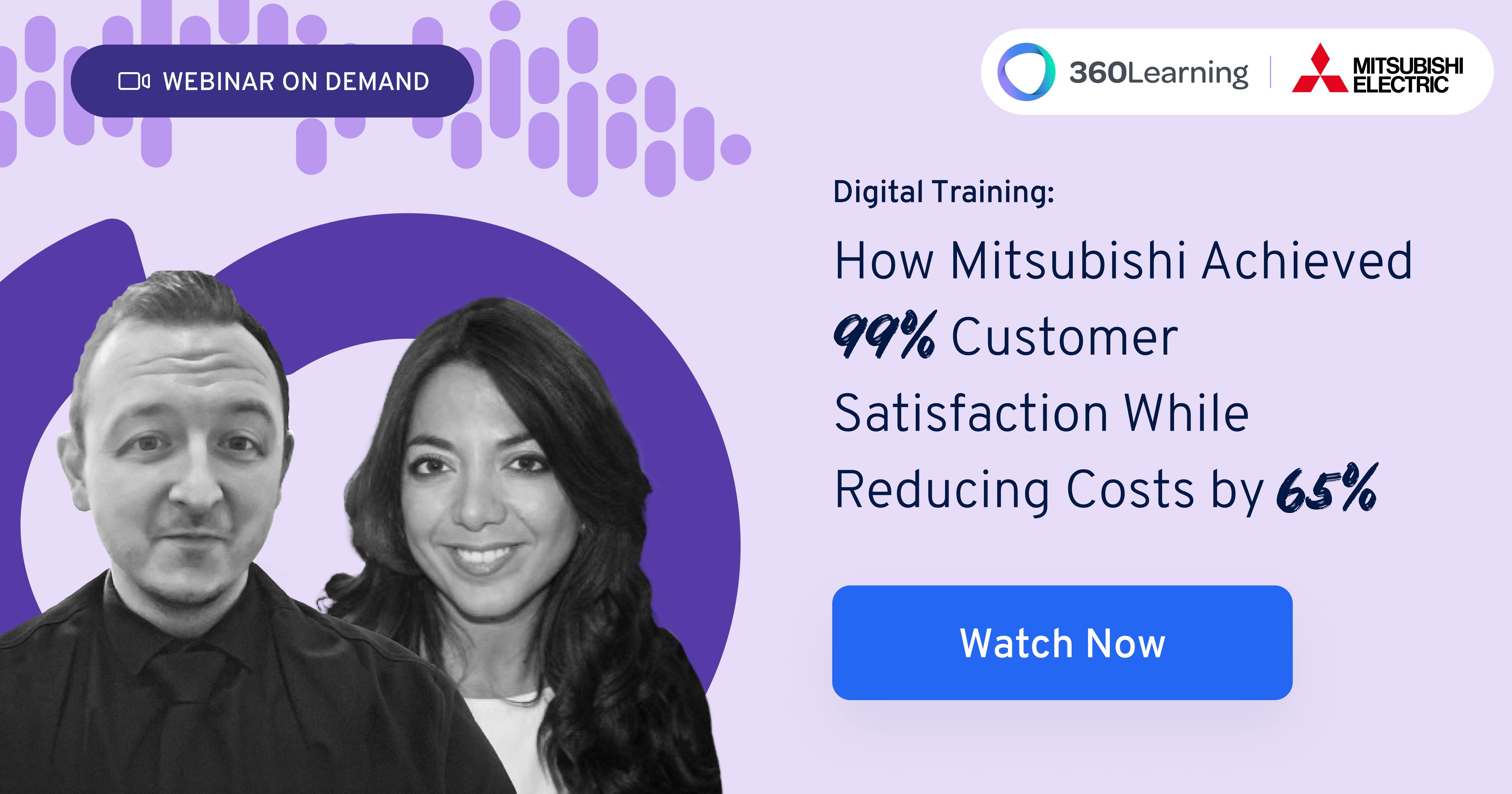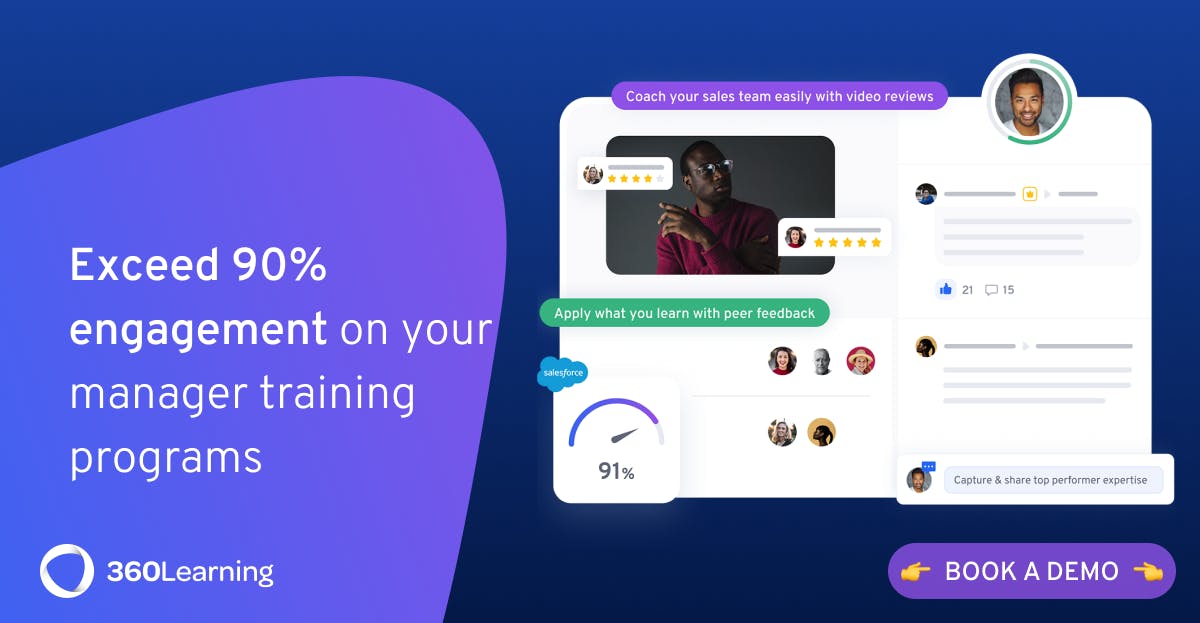
How Mitsubishi Electric Achieved 99% Customer Satisfaction While Reducing Training Costs by 65%
Company Overview
Originally founded in 1921, the company known today as Mitsubishi Electric has 100 years of experience in providing reliable, high-quality products and support to installers, specifiers, corporate clients and consumers all over the world.
Through continuous technological innovation and ceaseless creativity, Mitsubishi Electric aims to contribute to the realisation of a vibrant and sustainable society. That aim extends to the way in which the company trains their customer engineers.
Discover how Mitsubishi Electric has delivered training to over 2,000 customer engineers using a blended learning approach.
The challenge: Scale training whilst maintaining a high quality of service
Mitsubishi Electric is a market leader in heat pumps and air conditioning units around the world. To ensure a consistently high quality of service, they need to train thousands of customer engineers. This is already a tough job, but COVID-19 made it even harder.
We talk to L&D experts all the time, and we know the value of great customer education to provide seamless learning experiences and grow your bottom line. But, scaling the delivery of training and maintaining this high quality of service is a challenge for many companies– especially during a crisis.
For Lance Hitchins, Head of Customer Training at Mitsubishi Electric, meeting this challenge meant finding a new way to deliver training at scale, capture expert knowledge, and stay flexible despite the shift to remote working.
In a recent webinar, I talked to Lance about how Mitsubishi Electric used Collaborative Learning to achieve a 99% customer training satisfaction rate and reduce training costs by 65%.
Related: Datatrak’s 4-Step Playbook for Delivering Great Customer Learning Experiences
Mitsubishi Electric had to deliver more training than they could handle
For Lance, the biggest challenge he and his L&D team were facing was the sheer volume of customer training that was required from a business perspective. “We couldn’t cater to the volume of people coming through,” says Lance. “Back in June 2020, we had 1,500 people waiting to be enrolled on a course. Our wait times were simply too long and we really wanted to reduce that.”
Even before COVID-19 came along, Lance’s team faced constraints with training volume. They had huge uptake of their courses, delivered through static, classroom-based learning programmes. Their trainers would go through PowerPoint presentations and take people into product showrooms. Although this solution had high engagement amongst engineers, it wasn’t scalable.
“We couldn’t cater to the volume of people coming through,” says Lance. “Back in June 2020, we had 1,500 people waiting to be enrolled on a course. Our wait times were simply too long and we really wanted to reduce that.”
Ramping up the volume of training delivered with Mitsubishi Electric’s existing solution was not feasible. The classroom training could accommodate just 12 people in one room with live equipment, due to health and safety policies.
This way of training became even more problematic when COVID-19 hit. Luckily, Lance and his L&D team had already begun their journey with 360Learning, and so the pandemic naturally propelled the programme and forced them to ship the solution faster.
Get the full story on how Mitsubishi Electric is using Collaborative Learning to deliver training to over 2,000 people by watching the webinar on-demand.
The solution: Customer education delivered by experts
Lance and his L&D team focused their customer education programme around five key implementation areas. These were:
- Blended learning: Using an 80/20 model to deliver training
- Authoring: Developing content in-house with an authoring tool
- Social: Enabling learners to interact with trainers
- Engagement: Accessing dashboards to track engagement and usage
- Upskill: Supporting the L&D team to acquire new skills
For Lance, these five key implementation areas were critical to the success of the project. The first area involved defining the overall format of the programme with blended learning.
1. Blended learning: Using an 80/20 model to deliver training
According to Lance, some of Mitsubishi Electric’s customer engineers and contractors were not necessarily tech-savvy, with some having never used elearning before. This meant Lance needed to define the training needs and essentially change tact in how the training would be delivered.
Lance found that a blended learning solution—combining digitised courses and live webinars–would be the optimal choice for Mitsubishi Electric customers. He used an 80/20 model whereby they would aim to digitise 80% of the learning content and have 20% in a live, virtual workshop format.
As Lance explains, Mitsubishi Electric could have digitised 100% of its programmes. However, it was found through survey feedback that people related to the live webinars, as these provided a forum to speak to a trainer, ask questions, and have a live product demo tutorial. That’s why a blended learning approach offered such a good balance for their customer training.
When it came to digitising the current content, Lance and his L&D team needed to navigate the 360Learning platform and become familiar with key features. This started with learning how to author courses.
2. Authoring: Developing content in-house with an authoring tool
For Lance and his L&D team, having access to a good authoring tool was essential. “Working in L&D myself for over 12 years, I’ve seen first-hand how much costs can escalate when opting for a freelance designer. Freelancers often don’t know the business you work in so it was paramount to have an authoring tool our in-house team could use to pull together courses.”
360Learning’s Authoring Tool allows content to be created in-house by subject-matter experts at pace. Lance’s team has had great engagement from the rest of the organisation to help with course creation for customer education. In addition, this Authoring Tool makes it easy for Mitsubishi Electric’s subject-matter experts to quickly and easily update content to ensure relevancy.
Another aspect of Collaborative Learning that compliments an authoring tool? Social features.
3. Social: Enabling learners to interact with trainers
The social features offered through 360Learning allow Mitsubishi Electric customer engineers to post comments, provide feedback and ask questions to their trainer. Lance’s L&D team has put in place a service level agreement (SLA) to respond to questions within 24 hours from Monday-Friday to ensure learners have the information they need quickly.
As Lance says, “It’s been great to see the interactions between trainers and learners. Learners get the answers to all their questions and trainers save time by answering questions in one place.”
These interactions have proved invaluable. At the same time, Lance and his team have had to monitor them closely to measure the success of the project.
4. Engagement: Accessing dashboards to track engagement and usage
By digitising training, the L&D team has gained visibility into various training across Mitsubishi Electric. 360Learning’s dashboards help Lance monitor course completion rates, engagement and user feedback. With our Reactions feature, Lance can enable learners to give feedback in real-time.
“The engagement on the platform has been huge,” says Lance. “A lot of people react to the content and post comments on the chat for the team to answer. It’s a real benefit for our customers to know that their trainer is available throughout their course.”
5. Upskill: Supporting the L&D team to acquire new skills
The shift to digital training was a learning curve for Lance and his L&D team, as it was for many companies who shifted to remote learning when the COVID-19 pandemic hit. For Mitsubishi Electric, upskilling the L&D team was a big part of this shift. Learners required support to storyboard programmes, develop new types of content using third party tools, train in the 360Learning platform and set up live webinars.
Lance describes the important role his L&D team played in upskilling themselves. “My team’s attitude is really what drove this programme forward faster because they all came in with a positive mindset.”
Through the eagerness of the L&D team to learn and utilise the 360Learning platform, Lance’s L&D team have been able to engage their learners and scale their customer training.
Impact: 99% customer satisfaction rate, 65% reduced costs
With the L&D team upskilled and course creation well underway, Mitsubishi Electric has been able to transfer all the training over into a blended learning programme. They’ve also eliminated the backlog of customers waiting to enrol on courses.
Volume and efficiency results:
- The team is 900% more efficient
- The number of people trained has increased from 200 to 300 people per month
- The same volume of training has been delivered with 10% of the resources required before
- Training costs have been reduced by 65%
Customer impact:
- 99% customer satisfaction rate
- Mitsubishi Electric has reduced the wait time for customer training to 30 days
- The learner survey feedback is much more positive, with learners saying: - “I can do this in my own time”, and describing the training as “flexible”, “easy to use”, and “the best online training I have ever done”
Environmental impact:
- 600,000 miles of travelling saved
- 230,000 sheets of paper saved
It's clear from these results that the new digital training programme has had a positive impact on the Mitsubishi Electric business. So, what does the future hold for Lance and his L&D team?
What’s next for Mitsubishi Electric?
The transition from classroom-based learning to a digital and blended learning strategy enables Mitsubishi Electric to better meet its customer education needs. Now, the company can offer flexible and engaging customer learning, while also enabling the L&D team to utilise subject-matter experts to create content in-house.
“The positive feedback on our courses we’ve had from customers has been overwhelming,” says Lance. “And I feel a sense of pride when my staff are mentioned individually in courses by customers.”
So what’s next? Mitsubishi Electric will be working in collaboration with 360Learning to determine the long-term roadmap for their customer training. One of the key objectives for the future will be to leverage subject-matter experts within the business to help deliver product and sales training.
Want to leverage Collaborative Learning to scale your training? Get in touch with one of our Collaborative Learning consultants and see how we can help you.



